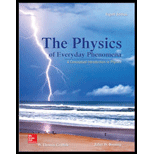
(a)
The efficiency of the Carnot engine.
(a)
Answer to Problem 3SP
The efficiency of the Carnot engine is
Explanation of Solution
Given info: Temperature of hot reservoir is
Write an expression to calculate the efficiency.
Here,
Substitute
Thus, the efficiency of the Carnot engine is
Conclusion:
The efficiency of the Carnot engine is
(b)
The work provided in each cycle.
(b)
Answer to Problem 3SP
The work provided in each cycle is
Explanation of Solution
Given info: Heat released to hot reservoir is
Write an expression for work provided in each cycle.
Here,
Substitute
Thus, work provided in each cycle is
Conclusion:
The work provided in each cycle is
(c)
The heat released from cold reservoir.
(c)
Answer to Problem 3SP
The heat released from cold reservoir is
Explanation of Solution
Write an expression for heat released from cold reservoir.
Here,
Substitute
Thus, the heat released from cold reservoir is
Conclusion:
The heat released from cold reservoir is
(d)
The coefficient of performance of the heat pump.
(d)
Answer to Problem 3SP
The coefficient of performance of the heat pump is
Explanation of Solution
Write an expression for coefficient of performance of the heat pump.
Here,
Substitute
Thus, the coefficient of performance of the heat pump is
Conclusion:
The coefficient of performance of the heat pump is
(e)
The possibility of application of the heat pump for home heating.
(e)
Answer to Problem 3SP
Yes, the heat pump can be used for home heating.
Explanation of Solution
For home heating only moderate energy range is required. That will be sufficient to increase the temperature of home slightly. Here for working of the pump, only moderate range of energy is required.
Since the energy required is moderate, the energy provided by the heat pump will be adequate. The energy release will be less compared to the energy required to run the heat pump.
Conclusion:
Yes, the heat pump can be used for home heating.
Want to see more full solutions like this?
Chapter 11 Solutions
The Physics of Everyday Phenomena
 College PhysicsPhysicsISBN:9781305952300Author:Raymond A. Serway, Chris VuillePublisher:Cengage Learning
College PhysicsPhysicsISBN:9781305952300Author:Raymond A. Serway, Chris VuillePublisher:Cengage Learning University Physics (14th Edition)PhysicsISBN:9780133969290Author:Hugh D. Young, Roger A. FreedmanPublisher:PEARSON
University Physics (14th Edition)PhysicsISBN:9780133969290Author:Hugh D. Young, Roger A. FreedmanPublisher:PEARSON Introduction To Quantum MechanicsPhysicsISBN:9781107189638Author:Griffiths, David J., Schroeter, Darrell F.Publisher:Cambridge University Press
Introduction To Quantum MechanicsPhysicsISBN:9781107189638Author:Griffiths, David J., Schroeter, Darrell F.Publisher:Cambridge University Press Physics for Scientists and EngineersPhysicsISBN:9781337553278Author:Raymond A. Serway, John W. JewettPublisher:Cengage Learning
Physics for Scientists and EngineersPhysicsISBN:9781337553278Author:Raymond A. Serway, John W. JewettPublisher:Cengage Learning Lecture- Tutorials for Introductory AstronomyPhysicsISBN:9780321820464Author:Edward E. Prather, Tim P. Slater, Jeff P. Adams, Gina BrissendenPublisher:Addison-Wesley
Lecture- Tutorials for Introductory AstronomyPhysicsISBN:9780321820464Author:Edward E. Prather, Tim P. Slater, Jeff P. Adams, Gina BrissendenPublisher:Addison-Wesley College Physics: A Strategic Approach (4th Editio...PhysicsISBN:9780134609034Author:Randall D. Knight (Professor Emeritus), Brian Jones, Stuart FieldPublisher:PEARSON
College Physics: A Strategic Approach (4th Editio...PhysicsISBN:9780134609034Author:Randall D. Knight (Professor Emeritus), Brian Jones, Stuart FieldPublisher:PEARSON





